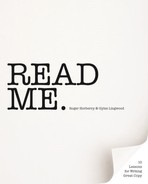Does the world really need another book on copywriting?
Aren’t bookstores around the globe already suitably stocked with similar stuff? Obviously we’re biased, but we think the answers to those questions are “yes” and “no”—in that order. Allow us to explain.
Many books on copywriting tell it like it ought to be, not like it is. In contrast, Read Me combines tried-and-tested techniques, practical knowledge, and hands-on exercises that reflect the rough and tumble of real-world copywriting. It’s the book we wanted when we were starting out, but couldn’t find because it wasn’t available. Now, decades later, we’re in the happy position of being able to share what we’ve learned from over 20 years each at the creative coalface. Read Me is the result.
For added oomph we’ve included contributions from some highly accomplished US and UK writers working in advertising, branding, design, and beyond. Their brief was simple: “What pearls of wisdom would you pass on to a cub copywriter or the young you?” The idea is to let you pick the brains of top practitioners working in a variety of areas who share many of the challenges copywriters face. No group has a monopoly on knowledge, and by sharing we all benefit.
Who this book is for
The short answer to this is anyone who uses words to engage and persuade their readers. The longer answer is anyone who works—or hopes to work—in advertising, design, branding, communications, PR, marketing, sales, or management. You might be a student looking for job-specific skills; you might be a teacher or trainer looking for course material. All brothers and sisters of the word are welcome here.
How it works
This book takes the form of ten self-contained lessons, each covering a subject or idea we believe copywriters need to know. Because these lessons are pretty modular you can read them in any order without suffering undue psychological damage, although starting at the beginning and working through to the end is probably your best bet.
We’ve made each lesson as practical as possible, so when we cover a slightly abstract subject like “audience” or “brand” we do it in a way that emphasizes “audiences and writing”, “brands and writing,” and so on. Absorbing and acting on this information will give your career a rocket-assisted launch and dramatically improve your understanding of how this business works.
Most of the lessons end with one or more workouts designed to sharpen your skills. We encourage you, urge you, beg you to have a go at these. The only way to improve at anything is to push yourself beyond where you feel comfortable, and by putting what you’ve read into practice you’ll get so much more from it. Best of all, you can upload your words to the workout area of this book’s website at www.readmewriting.com and see how others have responded to these challenges.
Why we’ve written it
Our main aim is to describe the art and craft of copywriting and the key skills you’ll need to succeed in this competitive but incredibly satisfying career. We also explore an underappreciated theme in contemporary copywriting—a theme we’ve christened “brandwriting.” Put all that together and this book is our take on what it means to write for—and about— brands in the twenty-first century.
How it came about
Read Me grew out of a series of lectures we developed for undergraduates taking the BA (Hons) Creative Advertising degree at the University of Lincoln in the UK. These, in turn, grew out of our individual research into important industry issues. Our approach reflects what Gyles and his academic colleagues describe as “research-informed teaching.” Much of our material— particularly the exercises at the end of each lesson— has been repeatedly tested in front of Lincoln’s advertising undergraduates, so as well as being a resource for copywriters, this book is also a ready-made professional writing course for trainers and teachers in industry and academia.
The important point is that each lesson reflects our conversations with industry figures and answers the real-world needs of students and junior writers. That’s what we mean when we describe a particular technique as “tried and tested.” We’re confident these approaches work for the simple reason they’ve repeatedly been shown to do so in both the classroom and the creative studio.
Lastly but not leastly, this book is the lovechild of Gyles and Roger working together in perfect harmony. That’s why we’ve written it in the third person plural—“we,” “us,” and so on. For the most part it describes our shared understanding, so this approach makes perfect sense. Here and there we need to write from an individual perspective, which means switching to the first person —“I,” “me,” and the like. Just think of Read Me as our combined opinion and you won’t go far wrong.
